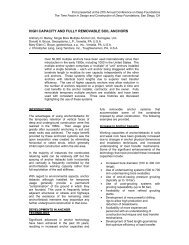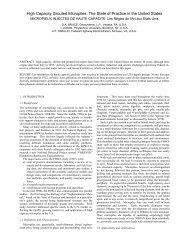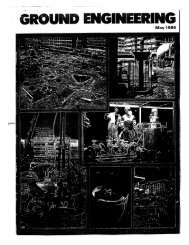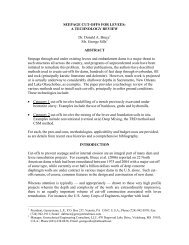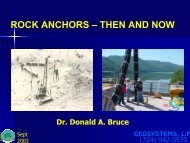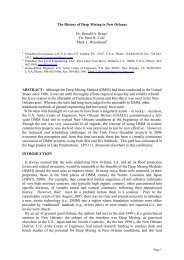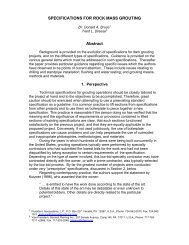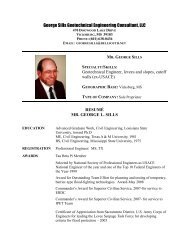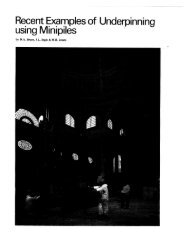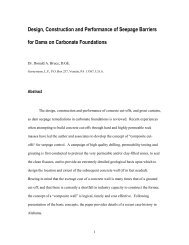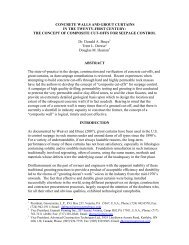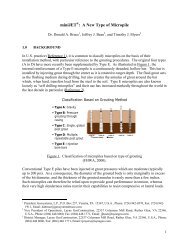1 Dam Remediation by Anchors and Cut-Offs: A ... - Geosystems, LP
1 Dam Remediation by Anchors and Cut-Offs: A ... - Geosystems, LP
1 Dam Remediation by Anchors and Cut-Offs: A ... - Geosystems, LP
Create successful ePaper yourself
Turn your PDF publications into a flip-book with our unique Google optimized e-Paper software.
For over 30 years, existing embankment dams have been remediated in North<br />
America <strong>by</strong> the use of cut-offs installed through the dam <strong>and</strong> into the underlying or<br />
abutting bedrock. These cut-offs are often referred to as “positive” since they involve<br />
the total excavation <strong>and</strong> replacement of in situ materials (i.e., fill, soil <strong>and</strong> rock), with<br />
a continuous diaphragm comprising a carefully engineered material, namely some<br />
type of concrete. Seepage cut-offs of this nature are required when the dam is judged<br />
to be progressing along the continuum of failure to the extent that failure of the<br />
embankment through piping into its foundation is a probability that cannot be ignored<br />
<strong>and</strong> must be rectified.<br />
This paper provides a brief review of North American practice in both anchors<br />
<strong>and</strong> cut-offs, as collated in two national research projects initiated <strong>by</strong> the author. The<br />
value of these studies will be as a reference source for practitioners involved in the<br />
design, construction <strong>and</strong> monitoring of major dam remediations using these particular<br />
techniques. More information on the anchor program may be found in Bruce <strong>and</strong><br />
Wolfhope (2005, 2006, 2007a, 2007b, 2007c), while Bruce et al. (2006) provides<br />
further data on cut-offs. This current paper describes only concrete cut-offs, whereas<br />
the paper <strong>by</strong> Bruce et al. (2006) details case histories involving cut-offs constructed<br />
<strong>by</strong> the Deep Mixing Method (FHWA 2000) <strong>and</strong> <strong>by</strong> backhoe as well. This decision<br />
has been made since the bulk of the work anticipated <strong>by</strong> the USACE, for example,<br />
will involve cut-offs comprising concrete only (Halpin, 2007).<br />
2. Rock <strong>Anchors</strong><br />
2.1 The Goals of the Program<br />
During the period 2005-2006, Phase 1 of the National Research Program was<br />
undertaken. This had three goals:<br />
(i) conduct a comparative review of the five successive versions of the national<br />
“Recommendations” documents which have guided (<strong>and</strong> reflected) U.S. practice<br />
since 1974,<br />
(ii) conduct a biography of all technical papers published on the subject of dam<br />
anchoring in North America, <strong>and</strong><br />
(iii) create a database containing as much information as possible on each structure<br />
anchored in North America.<br />
The program was funded <strong>by</strong> a consortium of U.S. <strong>and</strong> Japanese interests. The<br />
investigations relied heavily on the cooperation of specialty contractors <strong>and</strong> specialist<br />
post-tensioning suppliers who provided access to historical records.<br />
2.2 The Recommendations<br />
2.2.1 General Statement<br />
Current research indicates that the first U.S. dam to be stabilized <strong>by</strong> high capacity<br />
prestressed rock anchors was the John Hollis Bankhead Lock <strong>and</strong> <strong>Dam</strong>, Alabama<br />
(first 6 test anchors <strong>and</strong> 16 production anchors installed from 1962). This project was<br />
completed for the U.S. Army Corps of Engineers who had sufficient confidence in the<br />
2



